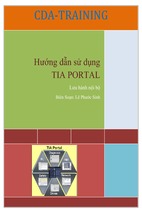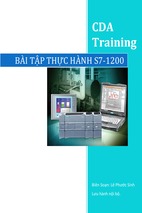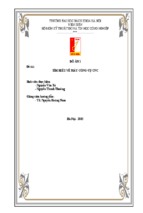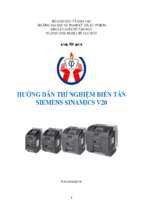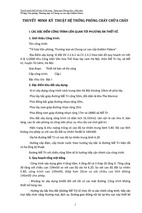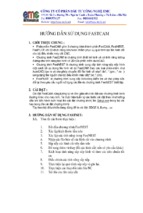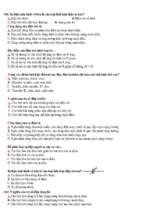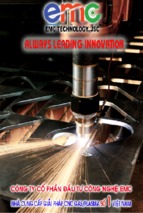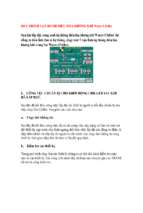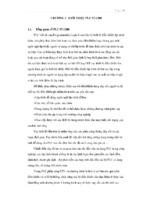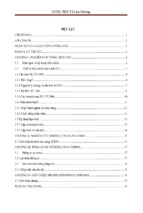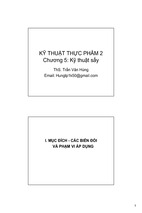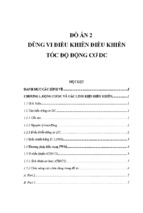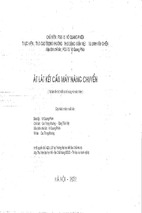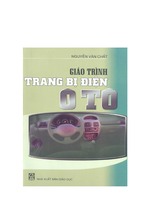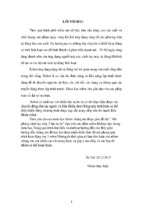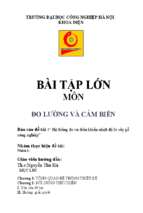Tài liệu hướng dẫn các bước lập trình chi tiết PLC và HMI trên TIA V14 PORTAL
Background and System Description 03/2017
Programming Guideline for
S7-1200/S7-1500
STEP 7 and STEP 7 Safety in TIA Portal
http://www.siemens.com/simatic-programming-guideline
Warranty and Liability
Warranty and Liability
Note
The Application Examples are not binding and do not claim to be complete
regarding the circuits shown, equipping and any eventuality. The Application
Examples do not represent customer-specific solutions. They are only intended
to provide support for typical applications. You are responsible for ensuring that
the described products are used correctly. These Application Examples do not
relieve you of the responsibility to use safe practices in application, installation,
operation and maintenance. When using these Application Examples, you
recognize that we cannot be made liable for any damage/claims beyond the
liability clause described. We reserve the right to make changes to these
Application Examples at any time without prior notice.
If there are any deviations between the recommendations provided in these
Application Examples and other Siemens publications – e.g. Catalogs – the
contents of the other documents have priority.
Siemens AG 2017 All rights reserved
We do not accept any liability for the information contained in this document.
Any claims against us – based on whatever legal reason – resulting from the use of
the examples, information, programs, engineering and performance data etc.,
described in this Application Example shall be excluded. Such an exclusion shall
not apply in the case of mandatory liability, e.g. under the German Product Liability
Act (“Produkthaftungsgesetz”), in case of intent, gross negligence, or injury of life,
body or health, guarantee for the quality of a product, fraudulent concealment of a
deficiency or breach of a condition which goes to the root of the contract
(“wesentliche Vertragspflichten”). The damages for a breach of a substantial
contractual obligation are, however, limited to the foreseeable damage, typical for
the type of contract, except in the event of intent or gross negligence or injury to
life, body or health. The above provisions do not imply a change of the burden of
proof to your detriment.
Any form of duplication or distribution of these Application Examples or excerpts
hereof is prohibited without the expressed consent of the Siemens AG.
Security
information
Siemens provides products and solutions with industrial security functions that
support the secure operation of plants, systems, machines and networks.
In order to protect plants, systems, machines and networks against cyber
threats, it is necessary to implement – and continuously maintain – a holistic,
state-of-the-art industrial security concept. Siemens’ products and solutions only
form one element of such a concept.
Customer is responsible to prevent unauthorized access to its plants, systems,
machines and networks. Systems, machines and components should only be
connected to the enterprise network or the internet if and to the extent necessary
and with appropriate security measures (e.g. use of firewalls and network
segmentation) in place.
Additionally, Siemens’ guidance on appropriate security measures should be
taken into account. For more information about industrial security, please visit
http://www.siemens.com/industrialsecurity.
Siemens’ products and solutions undergo continuous development to make them
more secure. Siemens strongly recommends to apply product updates as soon
as available and to always use the latest product versions. Use of product
versions that are no longer supported, and failure to apply latest updates may
increase customer’s exposure to cyber threats.
To stay informed about product updates, subscribe to the Siemens Industrial
Security RSS Feed under http://www.siemens.com/industrialsecurity.
Programming Guideline for S7-1200/S7-1500
Entry ID: 81318674, V1.5, 03/2017
2
Table of Contents
Table of Contents
Warranty and Liability ................................................................................................. 2
1
Preface ................................................................................................................ 6
2
S7-1200/S7-1500 innovations ........................................................................... 8
2.1
2.2
2.3
2.4
2.5
2.6
2.6.1
2.6.2
2.6.3
2.6.4
2.6.5
Siemens AG 2017 All rights reserved
2.6.6
2.7
2.7.1
2.7.2
2.7.3
2.8
2.8.1
2.8.2
2.8.3
2.8.4
2.8.5
2.9
2.9.1
2.9.2
2.9.3
2.9.4
2.9.5
2.10
2.10.1
2.10.2
2.11
2.12
2.13
2.14
3
Introduction ........................................................................................... 8
Terms ................................................................................................... 8
Programming languages .................................................................... 11
Optimized machine code .................................................................... 11
Block creation ..................................................................................... 12
Optimized blocks ................................................................................ 13
S7-1200: Structure of optimized blocks ............................................. 13
S7-1500: Structure of optimized blocks ............................................. 14
Processor-optimized data storage for S7-1500 ................................. 15
Conversion between optimized and non-optimized tags ................... 18
Parameter transfer between blocks with optimized and nonoptimized access ................................................................................ 19
Communication with optimized data .................................................. 20
Block properties .................................................................................. 21
Block sizes ......................................................................................... 21
Number of organization blocks (OB) .................................................. 21
Block interface – hide block parameters (V14 or higher) ................... 22
New data types for S7-1200/1500 ...................................................... 23
Elementary data types........................................................................ 23
Data type Date_Time_Long ............................................................... 24
Other time data types ......................................................................... 24
Unicode data types ............................................................................. 25
Data type VARIANT (S7-1500 and S7-1200 from FW4.1) ................. 26
Instructions ......................................................................................... 29
MOVE instructions .............................................................................. 29
VARIANT instructions (S7-1500 and S7-1200 FW4.1 and
higher) ................................................................................................ 31
RUNTIME ........................................................................................... 32
Comparison of tags from PLC data types (V14 or higher) ................. 33
Multiple assignment (V14 or higher) .................................................. 34
Symbolic and comments .................................................................... 35
Programming editor ............................................................................ 35
Comment lines in watch tables .......................................................... 36
System constants ............................................................................... 37
User constants ................................................................................... 38
Internal reference ID for controller and HMI tags ............................... 39
STOP mode in the event of errors ..................................................... 41
General Programming ..................................................................................... 42
3.1
3.2
3.2.1
3.2.2
3.2.3
3.2.4
3.2.5
3.2.6
3.2.7
3.2.8
3.2.9
3.2.10
Operating system and user program .................................................. 42
Program blocks .................................................................................. 42
Organization blocks (OB) ................................................................... 43
Functions (FC) .................................................................................... 45
Function blocks (FB) .......................................................................... 47
Instances ............................................................................................ 48
Multi-instances ................................................................................... 49
Transferring instance as parameters (V14)........................................ 51
Global data blocks (DB) ..................................................................... 52
Downloading without reinitialisation ................................................... 53
Reusability of blocks........................................................................... 57
Auto numbering of blocks ................................................................... 58
Programming Guideline for S7-1200/S7-1500
Entry ID: 81318674, V1.5, 03/2017
3
Table of Contents
Siemens AG 2017 All rights reserved
3.3
3.3.1
3.3.2
3.3.3
3.4
3.4.1
3.4.2
3.4.3
3.4.4
3.5
3.6
3.6.1
3.6.2
3.6.3
3.6.4
3.6.5
3.6.6
3.6.7
3.7
3.7.1
3.7.2
3.7.3
3.7.4
3.8
3.9
3.10
3.10.1
3.10.2
3.10.3
3.10.4
3.10.5
3.10.6
3.10.7
3.10.8
3.10.9
3.10.10
3.10.11
4
Hardware-Independent Programming ........................................................... 97
4.1
4.2
4.3
5
Block interface types .......................................................................... 59
Call-by-value ...................................................................................... 59
Call-by-reference ................................................................................ 59
Overview for transfer of parameters ................................................... 60
Memory concept ................................................................................. 60
Block interfaces as data exchange .................................................... 60
Global memory ................................................................................... 61
Local memory ..................................................................................... 62
Access speed of memory areas ......................................................... 63
Retentivity ........................................................................................... 64
Symbolic addressing .......................................................................... 67
Symbolic instead of absolute addressing ........................................... 67
ARRAY data type and indirect field accesses .................................... 69
Formal parameter Array [*] (V14 or higher)........................................ 71
STRUCT data type and PLC data types ............................................ 72
Access to I/O areas with PLC data types ........................................... 75
Slice access ....................................................................................... 76
SCL networks in LAD and FBD (V14 and higher) .............................. 77
Libraries .............................................................................................. 78
Types of libraries and library elements .............................................. 79
Type concept ...................................................................................... 80
Differences between the typifiable objects for CPU and HMI ............ 81
Versioning of a block .......................................................................... 81
Increased performance for hardware interrupts ................................. 86
Additional performance recommendations......................................... 88
SCL programming language: Tips and Tricks .................................... 89
Using call templates ........................................................................... 89
What instruction parameters are mandatory? .................................... 90
Drag-and-drop with entire tag names................................................. 90
Structuring with the keyword REGION (V14 or higher) ...................... 91
Correct use of FOR, REPEAT and WHILE loops .............................. 92
Using CASE instruction efficiently ...................................................... 93
No manipulation of loop counters for FOR loop ................................. 93
FOR loop backwards .......................................................................... 94
Easy creation of instances for calls .................................................... 94
Handling of time tags .......................................................................... 94
Unnecessary IF instruction ................................................................. 96
Data types of S7-300/400 and S7-1200/1500 .................................... 97
No bit memory but global data blocks ................................................ 99
Programming of "Cycle bits"............................................................... 99
STEP 7 Safety in the TIA Portal .................................................................... 100
5.1
5.2
5.3
5.4
5.5
5.6
5.7
5.8
5.9
5.9.1
5.9.2
5.10
5.11
5.12
Introduction ....................................................................................... 100
Terms ............................................................................................... 101
Components of the safety program .................................................. 102
F-runtime group ................................................................................ 103
F signature ....................................................................................... 103
Assigning the PROFIsafe address at the F-I/O ................................ 105
Evaluation of F-I/O ........................................................................... 105
Value status (S7-1200F/1500F) ....................................................... 106
Data types ........................................................................................ 107
Overview........................................................................................... 107
Implicit conversion ............................................................................ 107
F-conform PLC data type ................................................................. 109
TRUE / FALSE ................................................................................. 111
Optimizing the compilation and program runtime ............................ 112
Programming Guideline for S7-1200/S7-1500
Entry ID: 81318674, V1.5, 03/2017
4
Table of Contents
5.12.1
5.12.2
5.12.3
5.13
5.14
5.15
5.16
5.17
Avoiding of time-processing blocks: TP, TON, TOF ........................ 113
Avoiding deep call hierarchies ......................................................... 113
Avoiding JMP/Label structures ......................................................... 113
Data exchange between standard program and F program ............ 114
Testing the safety program............................................................... 115
STOP mode in the event of F errors ................................................ 116
Migration of safety programs ............................................................ 116
General recommendations for safety ............................................... 116
The Most Important Recommendations ...................................................... 117
7
Links & Literature .......................................................................................... 118
8
History............................................................................................................. 119
Siemens AG 2017 All rights reserved
6
Programming Guideline for S7-1200/S7-1500
Entry ID: 81318674, V1.5, 03/2017
5
1 Preface
1
Preface
Objective for the development of the new SIMATIC controller generation
An engineering framework for all automation components (controller, HMI,
drives, etc.)
Uniform programming
Increased performance
Complete set of command for every language
Fully symbolic program generation
Data handling also without pointer
Reusability of created blocks
Copyright Siemens AG 2017 All rights reserved
Objective of the guideline
The new controller generation SIMATIC S7-1200 and S7-1500 has an up-to-date
system architecture, and together with the TIA Portal offers new and efficient
options of programming and configuration. It is no longer the resources of the
controller (e.g. data storage in the memory) that are paramount but the actual
automation solution itself.
This document gives you many recommendations and notes on optimal
programming of S7-1200/1500 controllers. Some differences in the system
architecture of the S7-300/400, as well as the thus connected new programming
options are explained in an easy to understand way. This helps you to create
standardized and optimal programming of your automation solutions.
The examples described can be universally used for the controllers S7-1200 and
S7-1500.
Core contents of this programming guideline
The following key issues on the TIA Portal are dealt with in this document:
S7-1200/1500 innovations
–
Programming languages
–
Optimized blocks
–
Data types and instructions
Recommendations on general programming
–
Operating system and user program
–
Memory concept
–
Symbolic addressing
–
Libraries
Recommendations on hardware-independent programming
Recommendations on STEP 7 Safety in TIA Portal
Overview of the most important recommendations
Programming Guideline for S7-1200/S7-1500
Entry ID: 81318674, V1.5, 03/2017
6
1 Preface
Advantages and benefits
Numerous advantages result from applying these recommendations and tips:
Powerful user program
Clear program structures
Intuitive and effective programming solutions
Further information
When programming SIMATIC controllers, the task of the programmer is to create
as clear and readable a user program as possible. Each user uses their own
strategy, for example, how to name tags or blocks or the way of commenting. The
different philosophies of the programmers create very different user programs that
can only be interpreted by the respective programmer.
The programming style guide offers you coordinated set of rules for consistent
programming. These specifications for example describe a uniform assignment of
tags and block names right up to clear programming in SCL.
Copyright Siemens AG 2017 All rights reserved
You can use these rules and recommendations freely; they serve as a suggestion
(not a standard in programming) for consistent programming.
Note
The programming style guide for S7-1200 and S7-1500 can be found at the
following link:
https://support.industry.siemens.com/cs/ww/en/view/81318674
Programming Guideline for S7-1200/S7-1500
Entry ID: 81318674, V1.5, 03/2017
7
2 S7-1200/S7-1500 innovations
2.1 Introduction
2
S7-1200/S7-1500 innovations
2.1
Introduction
In general, the programming of the SIMATIC controllers from S7-300/400 to S71500 has stayed the same. There are the known programming languages such as
LAD, FBD, STL, SCL or graph and blocks such as organization blocks (OBs),
function blocks (FBs), functions (FCs) or data blocks (DBs). S7-300/400 programs
created can be easily implemented on S7-1500 and existing LAD, FBD and SCL
programs can be easily implemented on S7-1200 controllers.
In addition, there are many innovations that facilitate programming for you and
enables powerful and memory-saving code.
Copyright Siemens AG 2017 All rights reserved
For programs that are implemented for S7-1200/1500 controllers, we recommend
not to implement them one-to-one, but also to check new options and if possible, to
use them. The extra effort is often limited and you will receive a program code that
is, for example,
Note
optimal for memory and runtime for the new CPUs,
easier to understand,
and easier to maintain.
Information for the migration of S7-300/S7-400 to S7-1500 can be found in the
following entry:
https://support.industry.siemens.com/cs/ww/en/view/109478811
2.2
Terms
General terms in the TIA Portal
Some terms have change to enable easier handling with the TIA Portal.
Figure 2-1: New terms in the TIA Portal
STEP 7 V5.x
STEP 7 (TIA Portal)
Symbol table
PLC tags
UDT
PLC data types
Tag table
Watch table
Programming Guideline for S7-1200/S7-1500
Entry ID: 81318674, V1.5, 03/2017
8
2 S7-1200/S7-1500 innovations
2.2 Terms
Terms for tags and parameters
When dealing with tags, functions, and function blocks, many terms are repeatedly
used differently or even incorrectly. The following figure clarifies these terms.
Figure 2-2: Terms for tags and parameters
Globaler DB
2
FC / FB
1
3
4
Table 2-1: Terms for Tags and parameters
Copyright Siemens AG 2017 All rights reserved
Term
Description
1.
Tags
Tags are labeled by a name/identifier and use an
address in the memory of the controller. Tags are always
defined with a certain data type (Bool, Integer, etc.):
PLC tags
Individual tags in data blocks
Complete data blocks
2.
Tag value
Tag values are values stored in a tag (for example, 15 as
value of an integer tag).
3.
Actual parameter
Actual parameters are tags interconnected at the
interfaces of instructions, functions, and function blocks.
4.
Formal parameters
(transfer parameter,
block parameter)
Formal parameters are the interface parameters of
instructions, functions, and function blocks (Input,
Output, InOut, and Ret_Val).
Programming Guideline for S7-1200/S7-1500
Entry ID: 81318674, V1.5, 03/2017
9
2 S7-1200/S7-1500 innovations
2.2 Terms
Note
More information can be found in the following entries:
What entries are available on the internet for the migration to STEP 7 (TIA
Portal) and WinCC (TIA Portal)?
https://support.industry.siemens.com/cs/ww/en/view/56314851
What system requirements have to be fulfilled to migrate a STEP 7 V5.x project
in STEP 7 Professional (TIA Portal)?
https://support.industry.siemens.com/cs/ww/en/view/62100731
PLC migration to S7-1500 with STEP 7 (TIA Portal)
https://support.industry.siemens.com/cs/ww/en/view/67858106
How can you program efficiently and performant in STEP 7 (TIA Portal) for S71200/S7-1500?
https://support.industry.siemens.com/cs/ww/en/view/67582299
Copyright Siemens AG 2017 All rights reserved
Why is it not possible to mix register passing and explicit parameter transfer with
the S7-1500 in STEP 7 (TIA Portal)?
Among other topics, the migration of STL programs to S7-1500 is described in
this entry.
https://support.industry.siemens.com/cs/ww/en/view/67655405
Programming Guideline for S7-1200/S7-1500
Entry ID: 81318674, V1.5, 03/2017
10
2 S7-1200/S7-1500 innovations
2.3 Programming languages
2.3
Programming languages
Different programming languages are available for the programming of a user
program. Each language has its own advantages that can be used flexibly
depending on application. Thus, each block in the user program can be created in
any programming language.
Table 2-2: Programming languages
Programming language
Note
S7-1200
S7-1500
Ladder diagram (LAD)
yes
yes
Function block diagram (FBD)
yes
yes
Structured Control Language (SCL)
yes
yes
Graph
no
yes
Statement list (STL)
no
yes
More information can be found in the following entries:
Copyright Siemens AG 2017 All rights reserved
SIMATIC S7-1200 / S7-1500 Comparison List for Programming Languages
Based on the International Mnemonics
https://support.industry.siemens.com/cs/ww/en/view/86630375
What should you watch out for when migrating an S7-SCL program in STEP 7
(TIA Portal)?
https://support.industry.siemens.com/cs/ww/en/view/59784005
Which instructions can you not use in an SCL program in STEP 7 (TIA Portal)?
https://support.industry.siemens.com/cs/ww/en/view/58002709
How do you define the constants in an S7-SCL program in STEP 7 (TIA Portal)?
https://support.industry.siemens.com/cs/ww/en/view/52258437
2.4
Optimized machine code
TIA Portal and S7-1200/1500 enable an optimized runtime performance in every
programming language. All languages are compiled directly in machine code in the
same way.
Advantages
All programming languages have the same level of performance (for the same
access types)
No reduction of performance through additional compilation with interim step
via STL
Properties
In the following figure, the difference in the compilation of S7-programs in machine
code is displayed.
Programming Guideline for S7-1200/S7-1500
Entry ID: 81318674, V1.5, 03/2017
11
2 S7-1200/S7-1500 innovations
2.5 Block creation
Figure 2-3: Machine code creation with S7-300/400/WinAC and S7-1200/1500
S7-1200/1500
S7-300/400/WinAC
SCL
LAD
FBD
SCL
LAD
FBD
STL
(only S7-1500)
STL
Copyright Siemens AG 2017 All rights reserved
Maschine code
S7-300/400/WinAC
2.5
Maschine code
S7-1200/1500
For S7-300/400/WinAC controllers LAD and FBD programs are first compiled
in STL before machine code is created.
For S7-1200/1500 controllers all programming languages are directly compiled
in machine code.
Block creation
All blocks such as OBs, FBs and FCs can be directly programmed in the desired
programming language. Therefore no source has to be created for SCL
programming. Only select the block and SCL as programming language. You can
then program the block directly.
Figure 2-4: Dialog “Add new Block”
Programming Guideline for S7-1200/S7-1500
Entry ID: 81318674, V1.5, 03/2017
12
2 S7-1200/S7-1500 innovations
2.6 Optimized blocks
2.6
Optimized blocks
S7-1200/1500 controllers have an optimized data storage. In optimized blocks all
tags are automatically sorted according to their data type. The sorting ensures that
data gaps between the tags are reduced to a minimum and that the tags are stored
access-optimized for the processor.
Non-optimized blocks are only available for compatibility reasons in S7-1200/1500
controllers.
Copyright Siemens AG 2017 All rights reserved
Advantages
2.6.1
Access always takes place as quickly as possible since the data storage is
optimized by the system and independent of the declaration.
No danger of inconsistencies due to faulty, absolute access, since access is
generally symbolic
Declaration changes do not lead to access errors since, for example, HMI
access is symbolic.
Individual tags can be specifically defined as retentive.
No settings required in the instance data block. Everything is set in the
assigned FB (for example, retentivity).
Storage reserves in the data block enables changes without loss of current
values (see chapter 3.2.8 Downloading without reinitialisation).
S7-1200: Structure of optimized blocks
Figure 2-5: Optimized blocks for S7-1200
Standard block
Bits
Standard
0
0
1
2
3
4
Optimized
5
6
0
7
1
2
3
B1
X2
X3
3
4
5
6
7
W1
B
y
t
e
s
W2
B1
W1
5
6
4
X1
1
B
y
t
e
s
2
Optimized block
Bits
X1
X2
X3
X4
X3
7
8
W2
9
Properties
No data gaps are formed since larger tags are located at the start of a block
and smaller ones at the end.
There is only symbolic access for optimized blocks.
Programming Guideline for S7-1200/S7-1500
Entry ID: 81318674, V1.5, 03/2017
13
2 S7-1200/S7-1500 innovations
2.6 Optimized blocks
2.6.2
S7-1500: Structure of optimized blocks
Figure 2-6: Optimized blocks for S7-1500
Standard block
Bits
Standard
0
0
1
2
3
2
Optimized
4
5
6
0
7
2
3
4
5
6
7
W1
B1
X2
B
y
t
e
s
X3
3
4
W1
5
6
1
X1
1
B
y
t
e
s
Optimized block
Bits
W2
B1
X1
X2
X4
X3
7
X4
8
W2
Reserve
9
Copyright Siemens AG 2017 All rights reserved
Figure 2-7: Memory mapping for optimized blocks
Optimized
4 Byte are always read at once
DW
0
16
W
W
DW
W
B
1
W
W
B B B B X X X
Reserve
32
B
y
t
e
s
W
48
64
80
96
DW
102
128
W
B X X
DW
DW
W
W
2
Reserve
144
1. Structures are located separately and can therefore be copied as block.
2. Retentive data is located in a separate area and can be copied as block.
In the event of a loss of voltage this data is saved internally in the CPU.
“MRES” resets this data to the start values located in the load memory.
Properties
No data gaps are formed since larger tags are located at the start of a block
and smaller ones at the end.
Faster access due to processor-optimized storage (all tags are stored in a way
so that the processor of the S7-1500 can directly read or write them with only
one machine command).
Boolean tags are stored as byte for faster access. Thus, the controller does not
have to mask the access.
Programming Guideline for S7-1200/S7-1500
Entry ID: 81318674, V1.5, 03/2017
14
2 S7-1200/S7-1500 innovations
2.6 Optimized blocks
2.6.3
Optimized blocks have a storage reserve for loading in running operation (see
chapter 3.2.8 Downloading without reinitialisation).
There is only symbolic access for optimized blocks.
Processor-optimized data storage for S7-1500
For reasons of compatibility to the first SIMATIC controllers, the principle of the
“Big Endian” data storage was accepted in the S7-300/400 controllers.
Based on the changed processor architecture, the new S7-1500 controller
generation always accesses 4 byte (32 bit) in “Little-Endian” sequence. Thus the
following properties result on the system side.
Figure 2-8: Data access of a S7-1500 controller
Bits
Standard
0
1
2
4
5
6
7
Conversion for
processor access:
Big Little Endian
1
Copyright Siemens AG 2017 All rights reserved
3
BYTE
0
B
y
t
e
s
Optimized block
max. 16MB
2
0
3
1
4
2
5
3
6
X
REAL
Big-Endian
1
X
2
7
8
0
9
1
Copying requires time due to resorting!
Standard block
max. 64kB
Bits
Optimized
0
1
2
3
3
2
B
y
t
e
s
REAL
1
4
5
6
7
Best possible processor
data storage:
No conversion
required.
0 Little-Endian
1
1
WORD
0 Little-Endian
BYTE
X
X
WORD
Big-Endian
2
Reserve
Table 2-3: Data access of a S7-1500 controller
Standard block
Optimized block
1.
In the event of an unfavorable offset,
the controller requires 2x16 bit access
to read a 4 byte value (for example,
REAL value).
In addition the bytes have to be turned.
The controller stores the tags accessoptimized. Access is with 32 bit (REAL).
Turning the bytes is not required.
2.
The entire byte is read and masked per
bit access.
The complete byte is blocked for any
other access.
Each bit is assigned a byte.
The controller does not have to mask
the byte when accessing.
3.
Maximum block size is 64kB.
Maximum block size can be up to
16MB.
Programming Guideline for S7-1200/S7-1500
Entry ID: 81318674, V1.5, 03/2017
15
2 S7-1200/S7-1500 innovations
2.6 Optimized blocks
Recommendation
In general, only use optimized blocks.
–
You do not require absolute addressing and you can always address with
symbolic data (object-related). Indirect addressing is also possible with
symbolic data (see chapter 3.6.2 ARRAY data type and indirect field
accesses).
–
Processing optimized blocks in the controller is considerably faster than for
standard blocks.
Avoid the copying/assigning of data between optimized and non-optimized
blocks. The data conversion required between source and target format
requires high processing time.
Example: Setting optimized block access
Copyright Siemens AG 2017 All rights reserved
By default, the optimized block access is enabled for all newly created blocks for
S7-1200/1500. Block access can be set for OBs, FBs and global DBs. For instance
DBs, the setting derives from the respective FB.
Block access is not automatically reset if a block is migrated from a S7-300/400
controller to a S7-1200/1500. You can later change the block access to “Optimized
block access”. After changing the block access, you have to recompile the
program. If you change FBs to “Optimized block access”, the assigned instance
data blocks are automatically updated.
Follow the instructions to set the optimized block access.
Table 2-4: Setting optimized block access
Step
Instruction
1.
Click the “Maximizes/minimizes the Overview” button in the project tree.
2.
Navigate to “Program blocks”.
Programming Guideline for S7-1200/S7-1500
Entry ID: 81318674, V1.5, 03/2017
16
2 S7-1200/S7-1500 innovations
2.6 Optimized blocks
Step
3.
Instruction
Here, you see all blocks in the program and whether they are optimized or not.
In this overview the status “Optimized block access” can be conveniently
changed.
Note: Instance data blocks (here “Function_block_1_DB”) inherit the status
“optimized” from the associated FB. This is why the “optimized” setting can only
be changed on the FB. After the compilation of the project, the DB takes on the
status depending on the associated FB.
Copyright Siemens AG 2017 All rights reserved
Display of optimized and non-optimized blocks in the TIA Portal
In the two following figures the differences between an optimized and a nonoptimized instance DB can be seen.
For a global DB there are the same differences.
Figure 2-9: optimized data block (without offset)
Figure 2-10: non-optimized data block (with offset)
Table 2-5: Difference: Optimized and non-optimized data block
Optimized data block
Non-optimized data block
Optimized data blocks are addressed
symbolically. Therefore no “offset” is
shown.
For non-optimized blocks the “offset” is
shown and can be used for addressing.
In the optimized block you can declare
each tag individually with “Retain”.
In non-optimized blocks only all or no tag
can be declared with “Retain”.
Programming Guideline for S7-1200/S7-1500
Entry ID: 81318674, V1.5, 03/2017
17
2 S7-1200/S7-1500 innovations
2.6 Optimized blocks
The retentivity of tags of a global DB is directly defined in the global DB. By default,
non-retain is preset.
Define the retentivity of tags in an instance in the function block (not the instance
DB). These settings are therefore valid for all instances of this FB.
Access types for optimized and non-optimized data blocks
In the following table all access types for blocks are displayed.
Table 2-6: Access types
Copyright Siemens AG 2017 All rights reserved
Access type
Optimized block
Non-optimized
block
Symbolic
yes
yes
Indexed (fields)
yes
yes
Slice access
yes
yes
AT instruction
no
(Alternative: slice access)
yes
Direct absolute
no
(Alternative: ARRAY with INDEX)
yes
no
(Alternative: VARIANT /
ARRAY with index)
yes
yes
no
Indirect absolute (pointer)
Load without reinitialization
Note
More information can be found in the following entries:
What types of access are available in STEP 7 (TIA Portal) to access data values
in blocks and what should you watch out for with the differences between the
types?
https://support.industry.siemens.com/cs/ww/en/view/67655611
Which properties should you watch out for in STEP 7 (TIA Portal) for the
instructions "READ_DBL" and "WRIT_DBL" when using DBs with optimized
access?
https://support.industry.siemens.com/cs/ww/en/view/51434747
2.6.4
Conversion between optimized and non-optimized tags
It is generally recommended to work with optimized tags. However, if in individual
cases, you want to keep your programming so far, there will be a mix of optimized
and non-optimized data storage in the program.
The system knows the internal storage of each tag, irrelevant whether structured
(derived from an individually defined data type) or elementary (INT, LREAL, …).
For assignments with the same type between two tags with different memory
storage, the system converts automatically. This conversion requires performance
for structured tags and should therefore be avoided, if possible.
Programming Guideline for S7-1200/S7-1500
Entry ID: 81318674, V1.5, 03/2017
18
2 S7-1200/S7-1500 innovations
2.6 Optimized blocks
2.6.5
Parameter transfer between blocks with optimized and non-optimized
access
When you transfer structures to the called block as in/out parameters (InOut), they
are transferred by default as reference (see chapter 3.3.2 Call-by-reference).
However, this is not the case if one of the blocks has the property “Optimized
access" and the other block the property “Default access”. In this case, all
parameters are generally transferred as copy (see chapter 3.3.1 Call-by-value).
In this case the called block always works with the copied values. During block
processing, these values may be changed and they are copied back to the original
operand, after processing of the block call.
This may cause problems if the original operands are changed by asynchronous
processes, for example, by HMI access or interrupt OBs. If the copies are copied
back to the original operands after the block processing, the asynchronously
performed changes on the original operands are overwritten.
Copyright Siemens AG 2017 All rights reserved
Note
More information can be found in the following entries:
Why is data of the HMI system or the web server sometimes overwritten in the
S7-1500?
https://support.industry.siemens.com/cs/ww/en/view/109478253
Recommendation
Always set the same access type for the two blocks that communicate with
each other.
Programming Guideline for S7-1200/S7-1500
Entry ID: 81318674, V1.5, 03/2017
19
2 S7-1200/S7-1500 innovations
2.6 Optimized blocks
2.6.6
Communication with optimized data
The interface (CPU, CM) transfers the data in the way it is arranged (irrespective of
whether it is optimized or non-optimized).
Figure 2-11: CPU-CPU communication
Compatible
data transfer
(byte stream)
Send CPU
Copyright Siemens AG 2017 All rights reserved
0A
B1
32
39
Send data can be:
• optimized
• not optimized
• Tag (any type)
• Buffer (byte array)
4F
6D
7A
Receive CPU
…
FF
Receive data can be:
• optimized
• not optimized
• Tag (any type)
• Buffer (byte array)
Example
A tag with PLC data type (data record) shall be passed on to a CPU.
In the send CPU the tag is interconnected as actual parameter with the
communication block (TSEND_C).
In the receive CPU the receive data is assigned to a tag of the same type.
In this case symbolic work on the received data can be directly continued.
Note
Any tags or data blocks can be used as data records (derived from PLC data
types).
Note
It is also possible to define the send and receive data differently:
Send data
optimized
Receive data
-->
non-optimized -->
non-optimized
optimized
The controller automatically makes sure that the data transfer and storage is
correct.
Programming Guideline for S7-1200/S7-1500
Entry ID: 81318674, V1.5, 03/2017
20
- Xem thêm -

